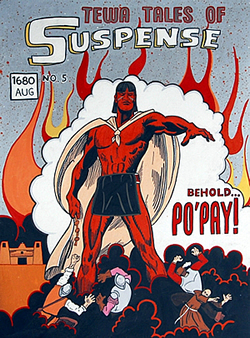A New Mexico museum exhibit shows the natural affinity tribal artists have had for the graphic storytelling techniques from Marvel and other comics.
"Comic strips were the first accessible form of mass media made available on reservations, and there was this immediate connection between native people and that type of work," said Antonio Chavarria, curator of ethnology, who organized the Comic Art Indigene exhibit. "There was no language barrier, and the whimsical stories were a very familiar tradition." Comics were consumed as a recognizable and legitimate form of storytelling.
Most of the art on display is a collection from regional artists, including Santana Shorty, Rose Bean Simpson and Marty Two Bulls, and their interpretation of politics, humor, culture and identity. Some of the contemporary work is based on older comic-art images; for instance, Diego Romero makes drawings which are interpretations of the Marvel Comics of the 1960s.
While one shouldn't get too carried away with comparing the Spider-Man seen on Pizza Hut cups to the sacred figures in Native creation stories, parallels can be drawn between ancient and modern stories: what excited the imagination then is not so different from what excites the imagination now. Comic Art Indigène, which opens at the Museum of Indian Arts & Culture on Sunday, May 11, identifies common threads in these stories and the way they've been told. Ancient artifacts offer evidence of art with a sequential theme, and certain Native American archetypes recur in modern comic books.
A pictograph of a shield-wielding, red, white, and blue warrior from the Pueblo II period (carbon-dated to circa 1290) is paired with a Jack Kirby drawing of that other shield-wielding, red, white, and blue warrior, Captain America.
Chavarria gathered a couple of Zuni pots that display evidence of direct correspondence between the visual language of traditional Native culture and current comic strips. "One shows the influence of the unique language that both Indian art and comic art have, because both of them developed their own indigenous languages. Comic art developed all these visual shorthands for action, like motion lines, sound effects, sweat drops, and the 'X's in the eyes to suggest an altered state of consciousness, like you're knocked out or something." The show displays this pot next to a Krazy Kat strip that also uses the "X" effect.
We also saw the connections between Native and comic-book art in the Montclair Art Museum exhibit I participated in last year. But that show emphasized the social themes, whereas this show appears to emphasize the artistic styles.
For more on the subject, see Comic Books Featuring Indians.
Below: "Tewa Tales of Suspense: Behold...Po'pay!" by Jason Garcia:

The source for this image:


1 comment:
Don't forget the strong Meso-American artistic influence on such creations as Jack Kirby's Galactus.
Post a Comment